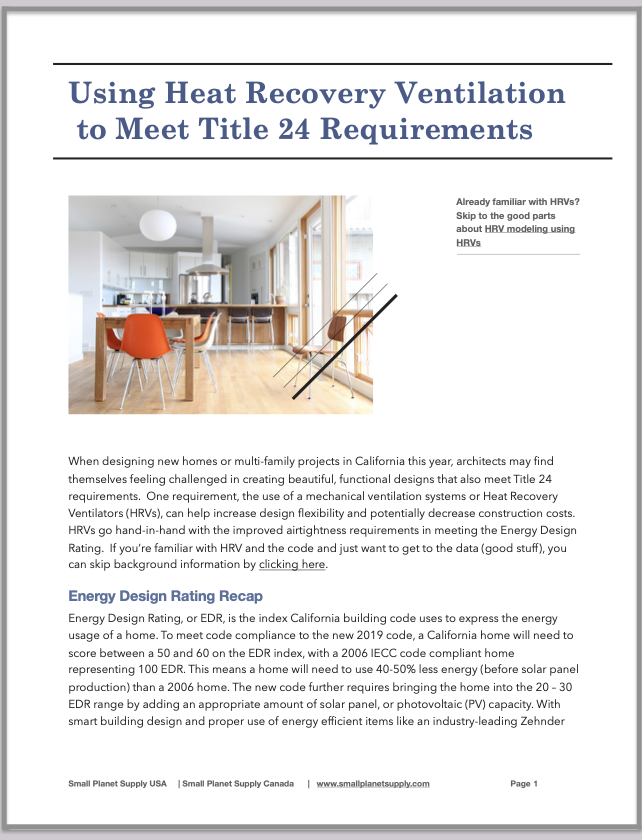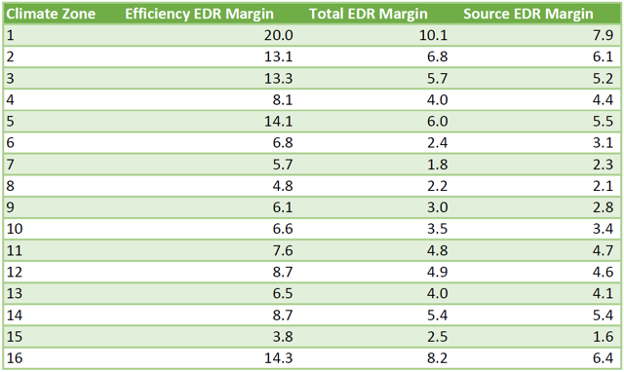California's Title 24, The Recovery Ventilator, and You
/In our 2020 blog post, HRVs and How They Help Achieve California's Title 24 Code Compliance, we outlined how the new mandatory building code energy credits system works, and how a recovery ventilator can give a massive boost to EDR credits. California’s Title 24 requirements continue to call for improvements to a new building’s energy usage, and we’re back with more data further prove that best-in-class recovery ventilators are the way to go for efficiency, comfort, and meeting regulations. Based on tests done by Build Smart Group and Luke Morton, Mortan Building Group, the following findings display just how beneficial any Recovery Ventilator can be, and especially so for best-in-class, such as the Zehnder systems carried by Small Planet Supply.
Best in Class Recovery Ventilators Provide Significant Energy Savings
In the last series of tests, it was shown that the inclusion of any recovery ventilator will provide energy savings and improve EDR credit scores. Recovery ventilators allow for these savings because of the intrinsic way they work. By recovering heat in exhaust air and warming up fresh intake air, the heating load on heating and cooling equipment is reduced. This alone has a great effect on overall energy use.
Where Zehnder’s recovery ventilators improve on this is in overall system efficiency. Because Zehnder uses better parts and the latest technologies, the whole system is able to operate at a lower energy use. One of the key energy savings comes from the blower motors/fans. Zehnder uses ECM motors to lower total energy consumed by the fans, which generally run all of the time to provide fresh filtered air. ECM motors run off of a microprocessor which controls the motor’s regulation of airflow and allows for modulation of RPM to be able to accommodate conditions. The result is a system that uses less energy while still providing optimal performance for any given condition.
Study Shows How Using HRVs Impacts Energy Use
In a study performed by Build Smart, they found that typical recovery ventilators save up to 11-15% HVAC-related energy (in Climate Zones 1-5, for a single-family home using a gas furnace), allowing for considerable energy code compliance credits. Savings are split three ways between cooling (kWh), ventilation fan energy (kWh), and heating (in therms for gas furnace equipped houses). Since the baseline single family home requires only exhaust ventilation, which needs no fan, a single-family home equipped with a recovery ventilator will always use more energy in this area. The results also showed significant savings from the best-in-class recovery ventilators, showing ~30% reduction in HVAC energy use in the same conditions.
Multifamily homes are not excluded from these energy savings. Their modeling and testing showed that a multifamily building using a gas furnace showed significant energy savings when outfitted with a best-in-class recovery ventilator. In climate zones 1-5, using a best-in-class recovery ventilator all showed >50% energy savings for the whole building. Other zones showed an average of ~33%, with benefits showing in both heating and cooling environments. Multifamily buildings’ baseline includes balanced ventilation as default in Title 24 requirements, this makes the ventilation fan savings more apparent in these buildings.
While the largest benefits were seen in buildings modeled with gas furnaces, even heat pump mini split systems saw energy savings. Heat pump systems are already very efficient, and a best-in-class recovery ventilator contributes to an even more efficient HVAC system overall in most climate zones, with climate zones 1-5 showing the best results with an average of ~17% for single family homes, and an average of ~42% for the whole building in multifamily homes.
Homes in climate zones that see predominantly cooling HVAC usage (zones 7-9, and 15) see less savings in the heating season, but still see significant savings during cooling use. A single-family home in cooling dominated zones would see about 50 kWh savings, and a multifamily home in those zones would see an average of 735 kWh savings.
Energy Savings’ Impact on EDR Credits
Graphiic: EDR Impact for 2100 sq ft single family home with gas furnace
All of these energy savings mean a lower electricity bill at the end of the year and provide some relief to a strained power grid. All of these benefits are realized after the home has been constructed, but there are still gains to be had in the development phase as well.
Graphic: EDR impact for multi-family building with gas furnace
To meet CA’s Title 24, newly constructed homes will need to meet an EDR margin for their climate zone. There are many ways to meet the requirements, but a Recovery Ventilator is by far one of the most impactful. 2022 introduces expanded EDR scoring metrics. In short, these are as follows: EDRe is the efficiency metric and considers the energy used by the envelope, IAQ, HVAC, DHW, and unregulated loads. The EDRt is the total metric which factors in photovoltaic energy. The newest metric is EDRs, or the source metric, and is based on the hourly source energy for carbon analysis measured in KBTU/sf per year and is aimed at helping with decarbonization and electrification. All newly constructed homes must meet these three EDR metrics. '
In single-family homes with gas furnaces, the average Efficiency EDR impact was ~10, with zones 1-5, 12, and 16 showing the highest impact with an average of 13 credits. Total EDR margin impact for those highest impacted zones was ~7.5 credits, and Source EDR margin impact saw ~10 credits in these climate zones.
By far the highest impacted is climate zone 1, seeing credit margin impacts of 21.3 EDRe, 11.7 EDRt, and 15.5 EDRs for a 2100 sq ft single family home with a gas furnace. Even homes with heat pump HVAC can see big EDR credit gains from a best-in-class recovery ventilator. The same single-family home would still get 20 EDRe, 10.1 EDRt, and 7.9 EDRs credits.
Multifamily homes see these same great EDR credit margin impacts, with the largest gains in the same climate zones.
Greenhouse Gas Emissions Reduction
Ancillary to the energy reduction and EDR credit impact is the effect recovery ventilators can have on greenhouse gas emissions. Any energy savings in homes has an impact on total energy used, and therefore impacts the production of greenhouse gasses. Typical recovery ventilators can provide up to an 8% savings in emissions. These savings can be even further improved by use of a best-in-class recovery ventilators, seeing up to .5 tons, or 14% per single-family home.
Multifamily buildings show even greater savings, with a typical system showing up to 15% savings, and a best-in-class system improving that metric to 20% greenhouse gas emissions savings.
Graphic: EDR impact for 2100 sq ft SINGLE family home with heat pump
Graphic: EDR impact for multi family building with heat pump
Looking at these numbers it is easy to see how impactful and important recovery ventilators will be going forward. The increase in HVAC related energy savings come in part from more efficient technology, but also from the larger percentage of indoor air heat recovery obtained from best-in-class recovery ventilators. These energy savings and EDR credit impact mean that recovery ventilators like the Zehnder systems available through Small Planet Supply will be in high demand moving forward. These systems have long had a place in the Performance Method of building and meeting energy code requirements, but these could soon see a place in the standard Prescriptive Method outlined in building code. The bonus effect on greenhouse gas emissions is a net positive for the environment as well, and the more buildings that utilize these systems, the greater that impact will be. Combined with the use of heat pumps, proper insulation, airtight building envelopes, and recovery ventilators, buildings of the future can be more efficient, more comfortable, and better for the planet. If you are interested in using a Zehnder system in your next build, head over to Zehnder America’s website to request a quote. Small Planet Supply is the west coast distributor of Zehnder System’s and will reach out once a design is drafted by Zehnder’s technicians.
Greenhouse Gas Emissions Reduction
Ancillary to the energy reduction and EDR credit impact is the effect recovery ventilators can have on greenhouse gas emissions. Any energy savings in homes has an impact on total energy used, and therefore impacts the production of greenhouse gasses. Typical recovery ventilators can provide up to an 8% savings in emissions. These savings can be even further improved by use of a best-in-class recovery ventilators, seeing up to .5 tons, or 14% per single-family home. Multifamily buildings show even greater savings, with a typical system showing up to 15% savings, and a best-in-class system improving that metric to 20% greenhouse gas emissions savings.
Looking at these numbers it is easy to see how impactful and important recovery ventilators will be going forward. The increase in HVAC related energy savings come in part from more efficient technology, but also from the larger percentage of indoor air heat recovery obtained from best-in-class recovery ventilators. These energy savings and EDR credit impact mean that recovery ventilators like the Zehnder systems available through Small Planet Supply will be in high demand moving forward. These systems have long had a place in the Performance Method of building and meeting energy code requirements, but these could soon see a place in the standard Prescriptive Method outlined in building code. The bonus effect on greenhouse gas emissions is a net positive for the environment as well, and the more buildings that utilize these systems, the greater that impact will be. Combined with the use of heat pumps, proper insulation, airtight building envelopes, and recovery ventilators, buildings of the future can be more efficient, more comfortable, and better for the planet.
If you are interested in using a Zehnder system in your next build, you can learn more about Zehnder products at the Zehnder page of our website or request a consultation to see if a Zehnder to learn how Zehnder products can help you breathe easy when working to meet your Title 24 code on your next build. Zehnder’s incredible ventilation filtration will ensure that your build’s residents will breathe easy too!

















